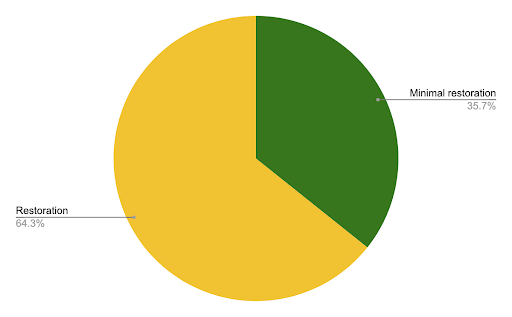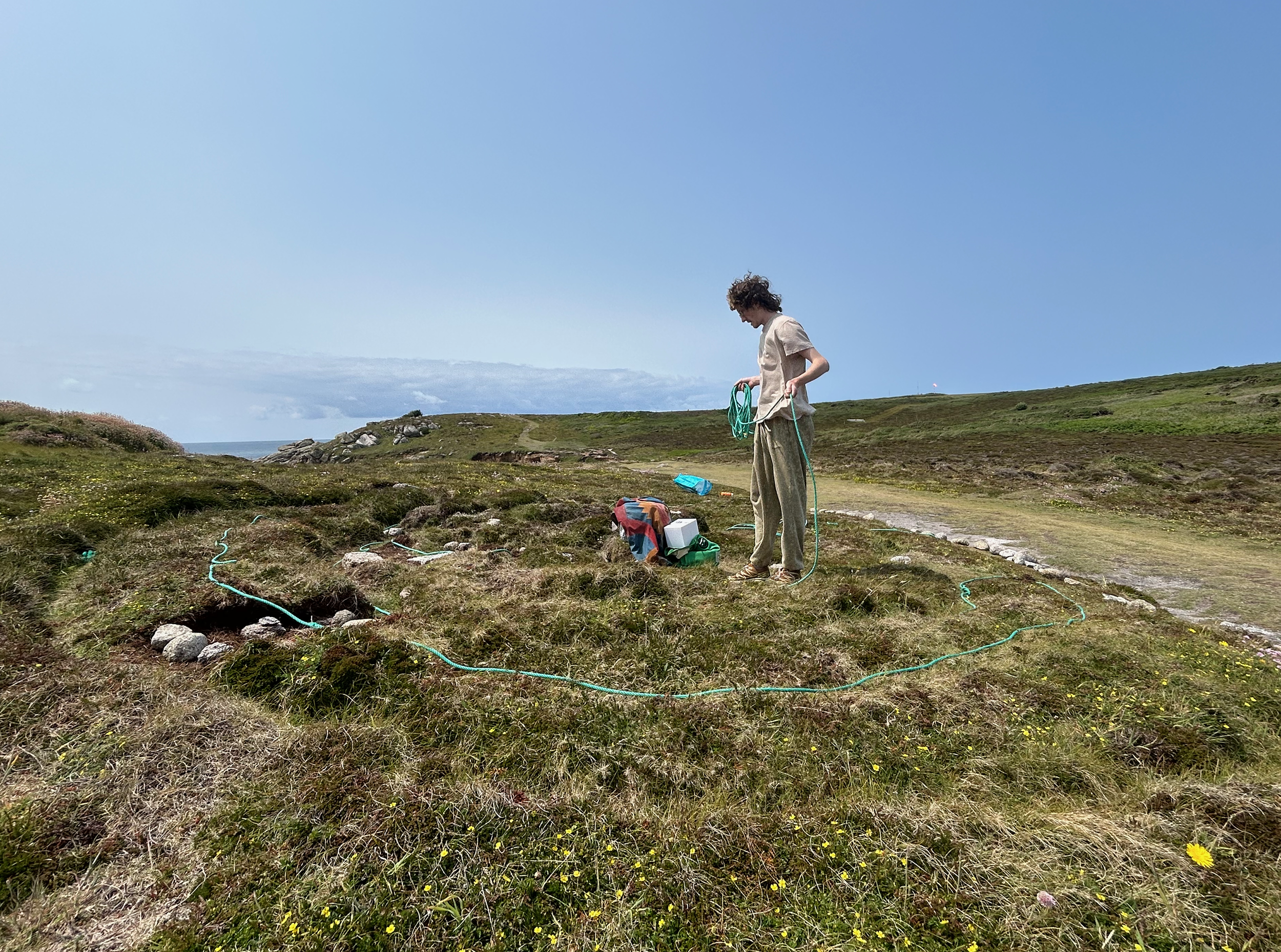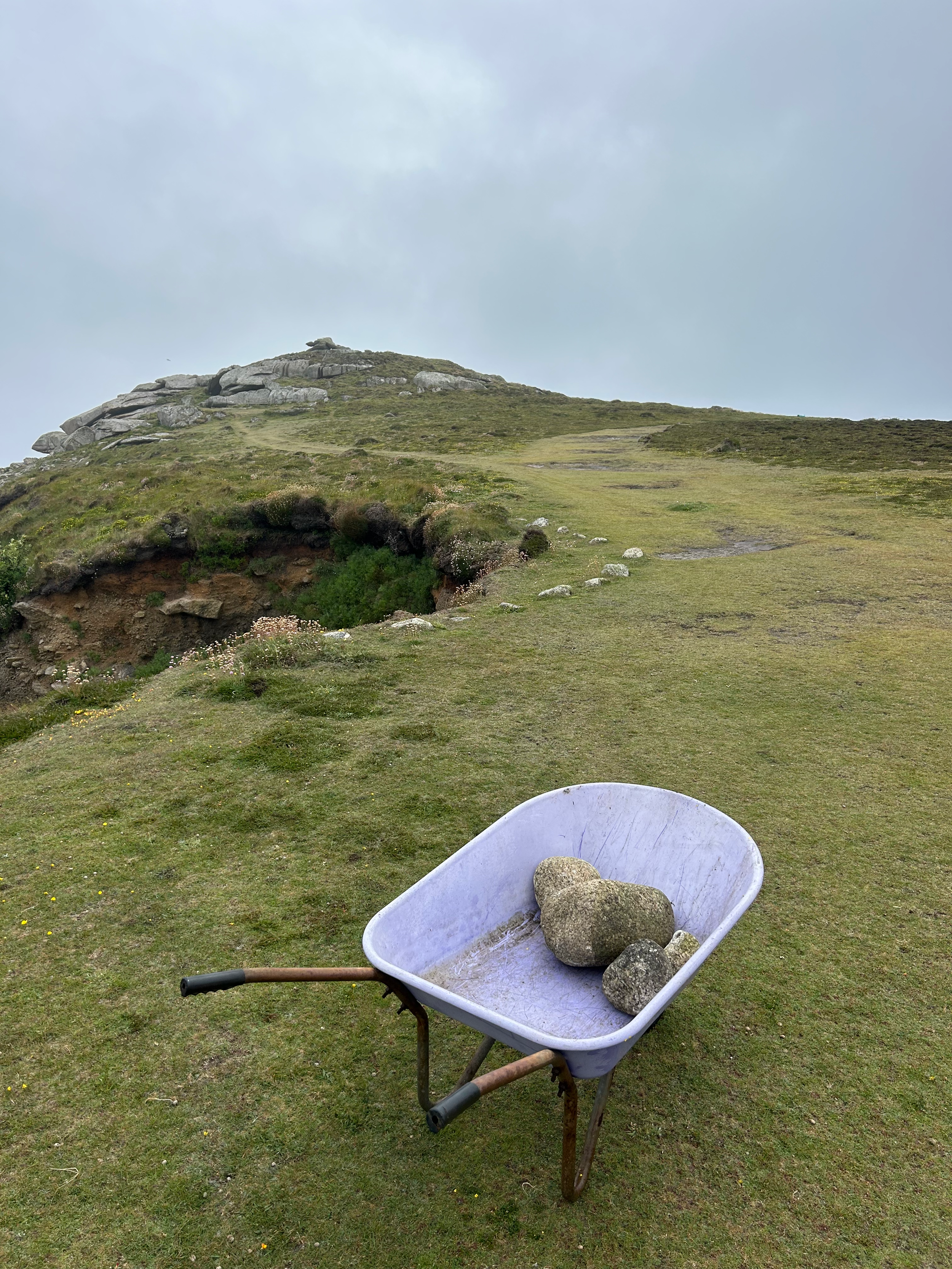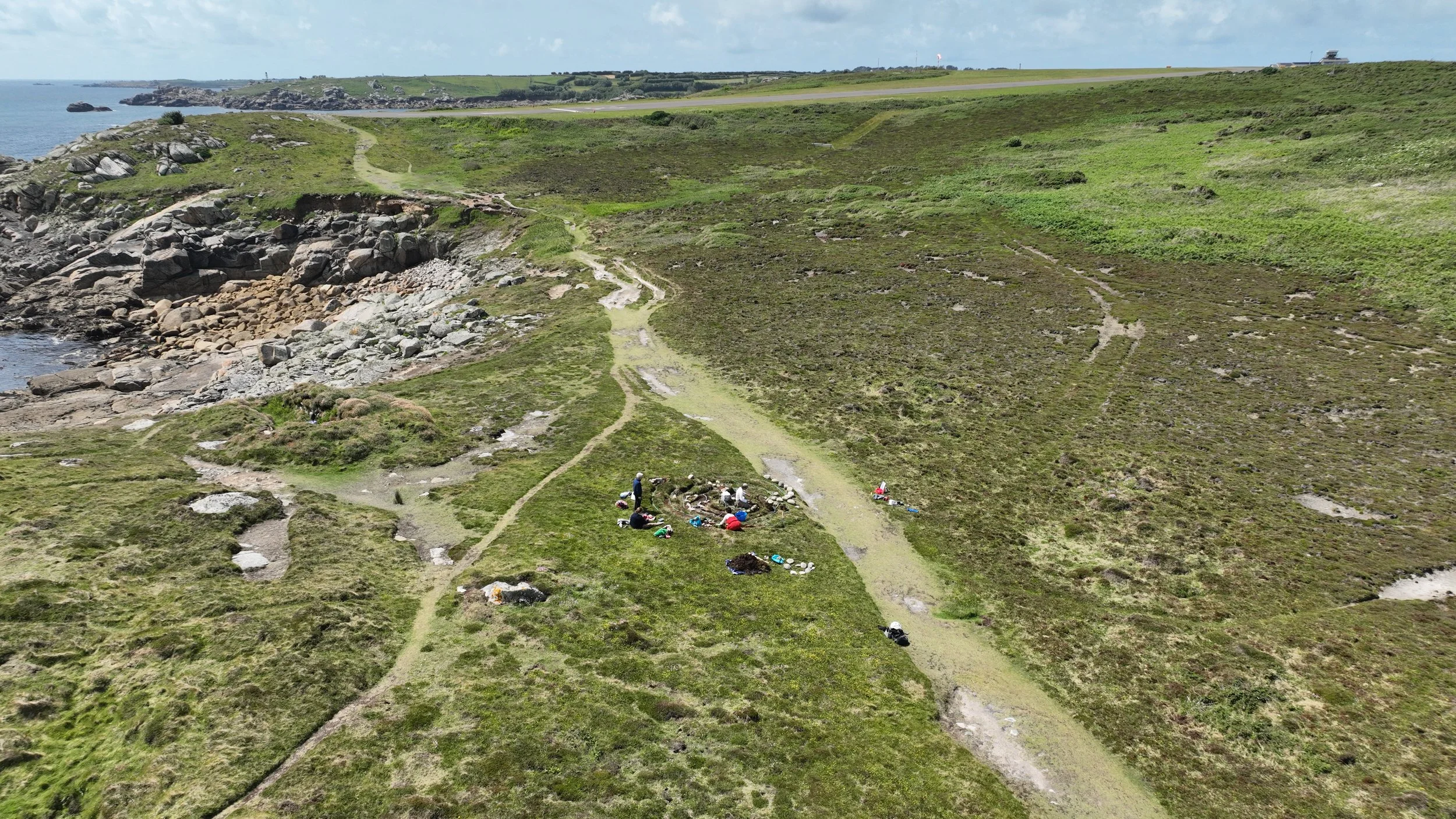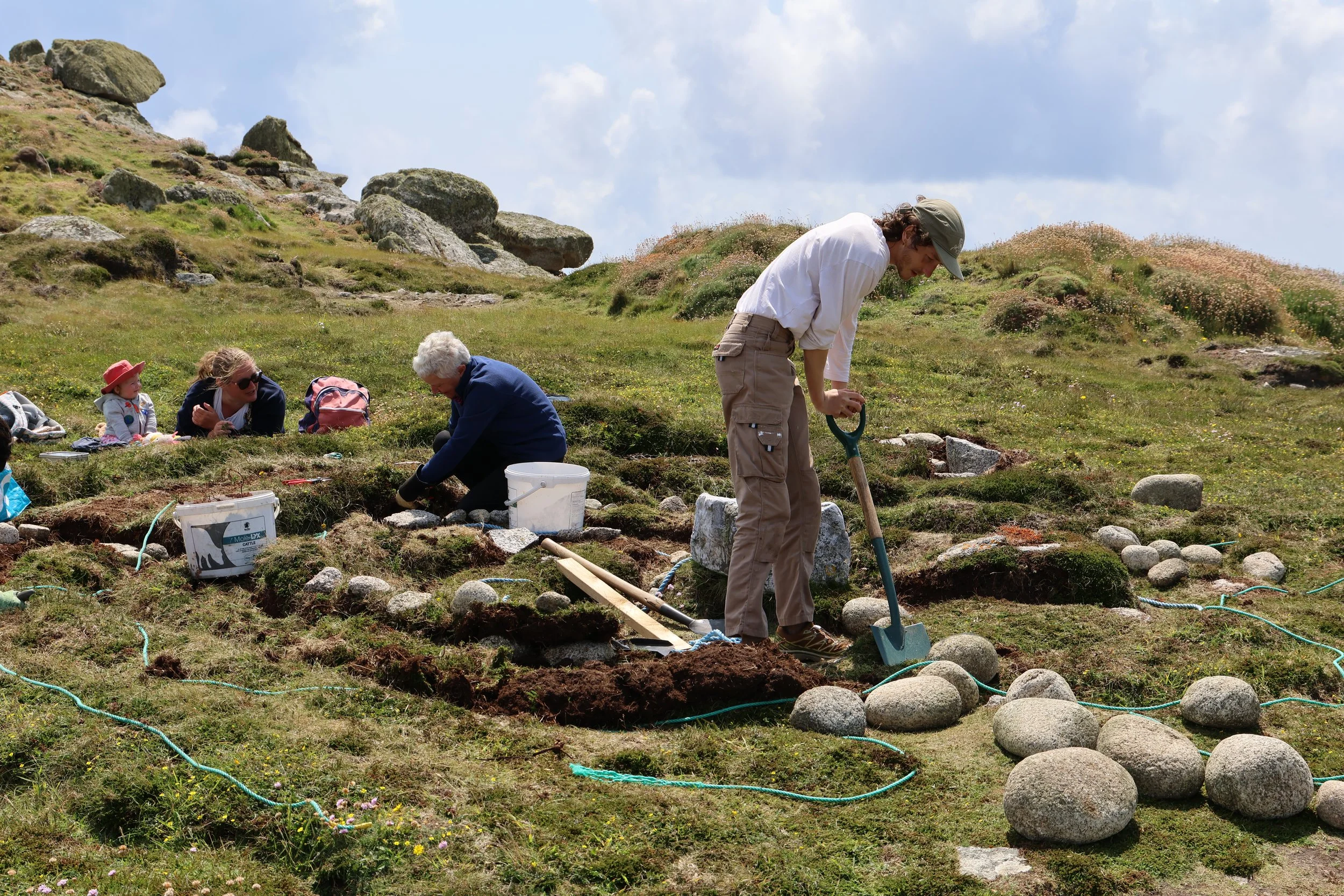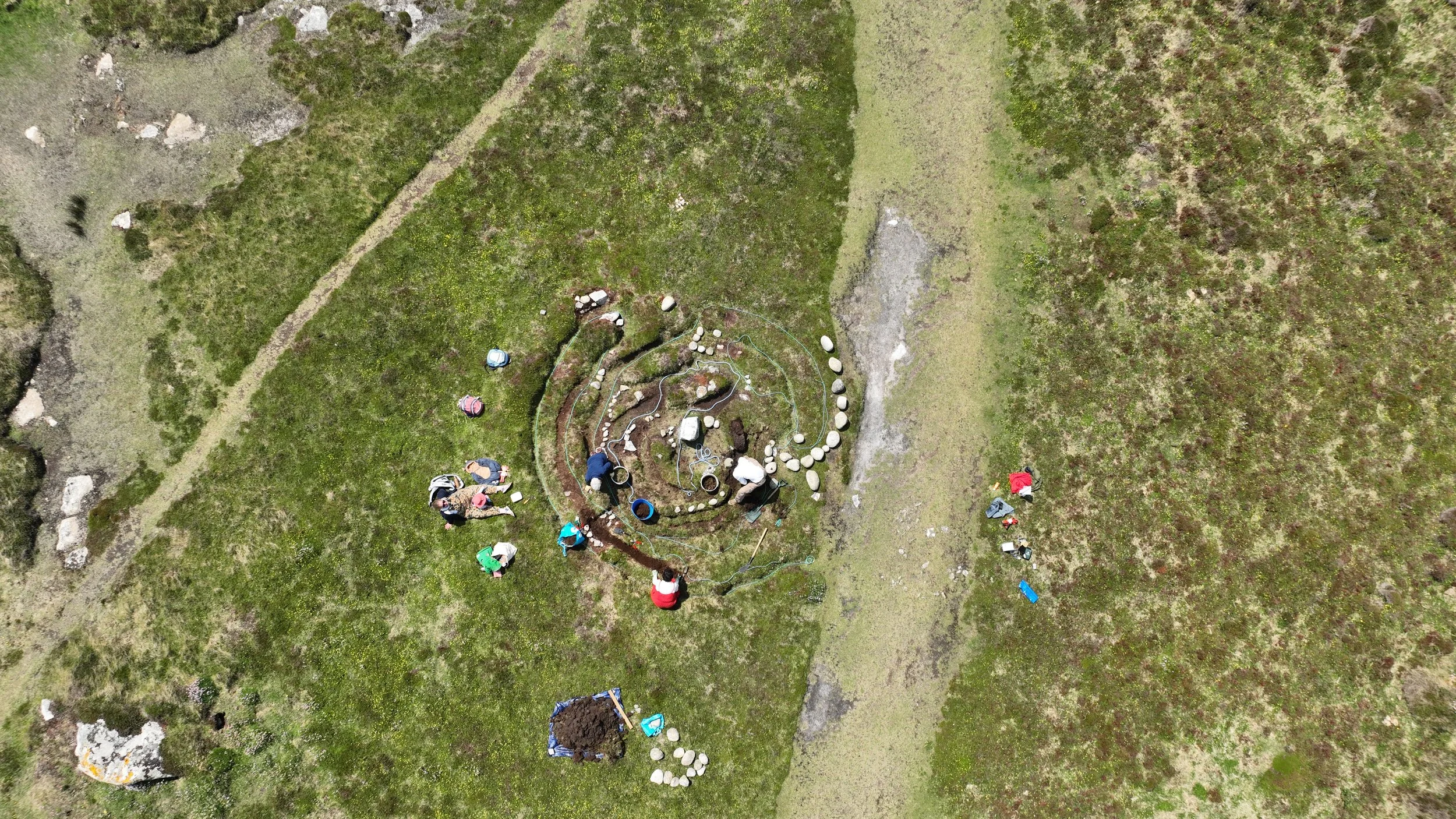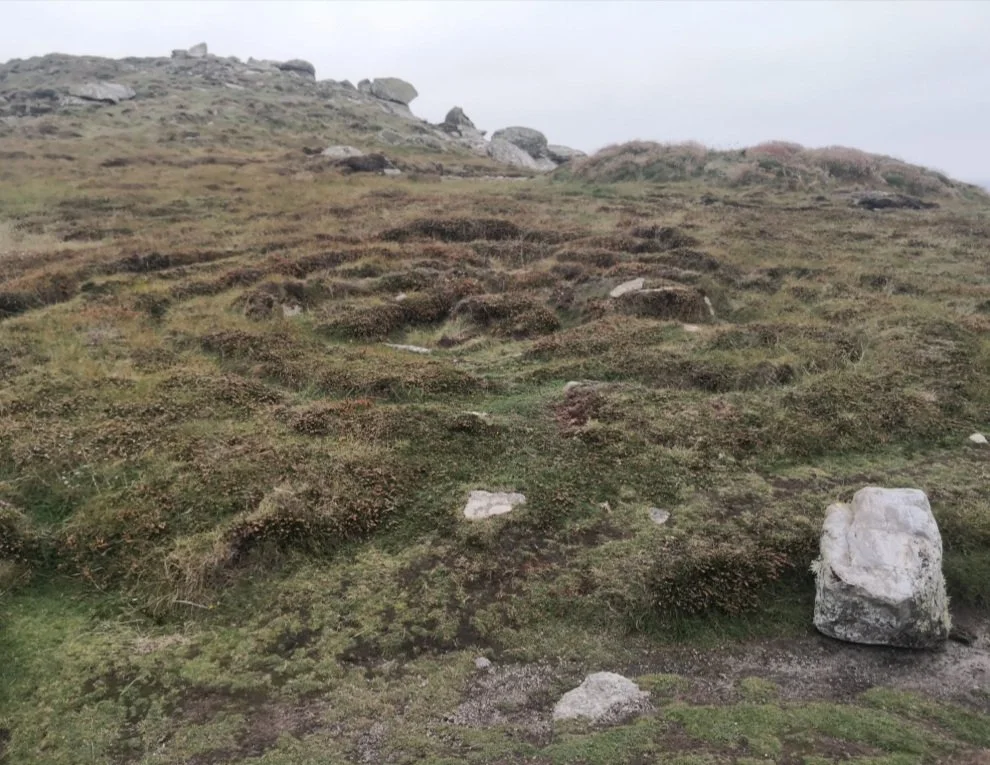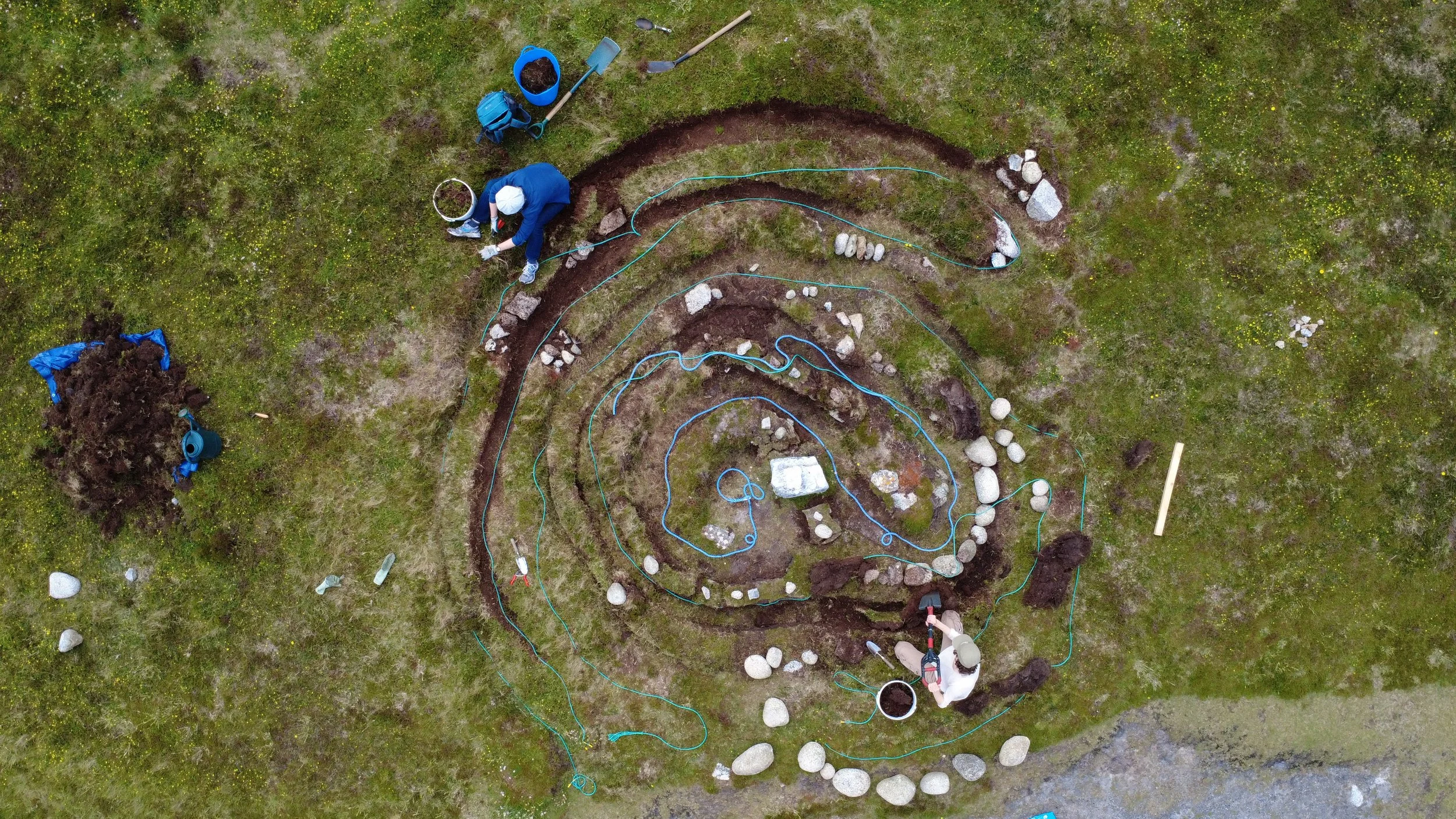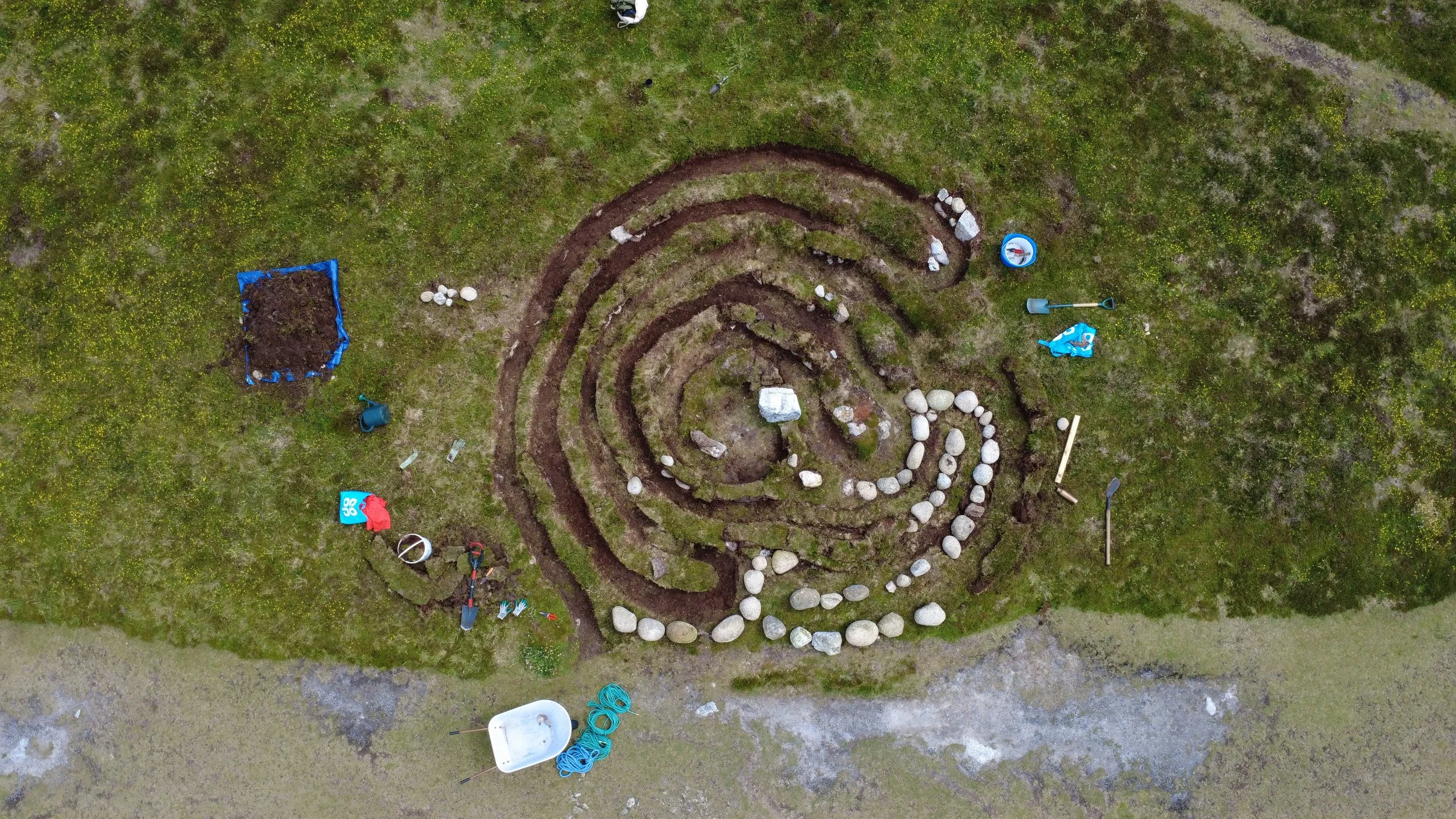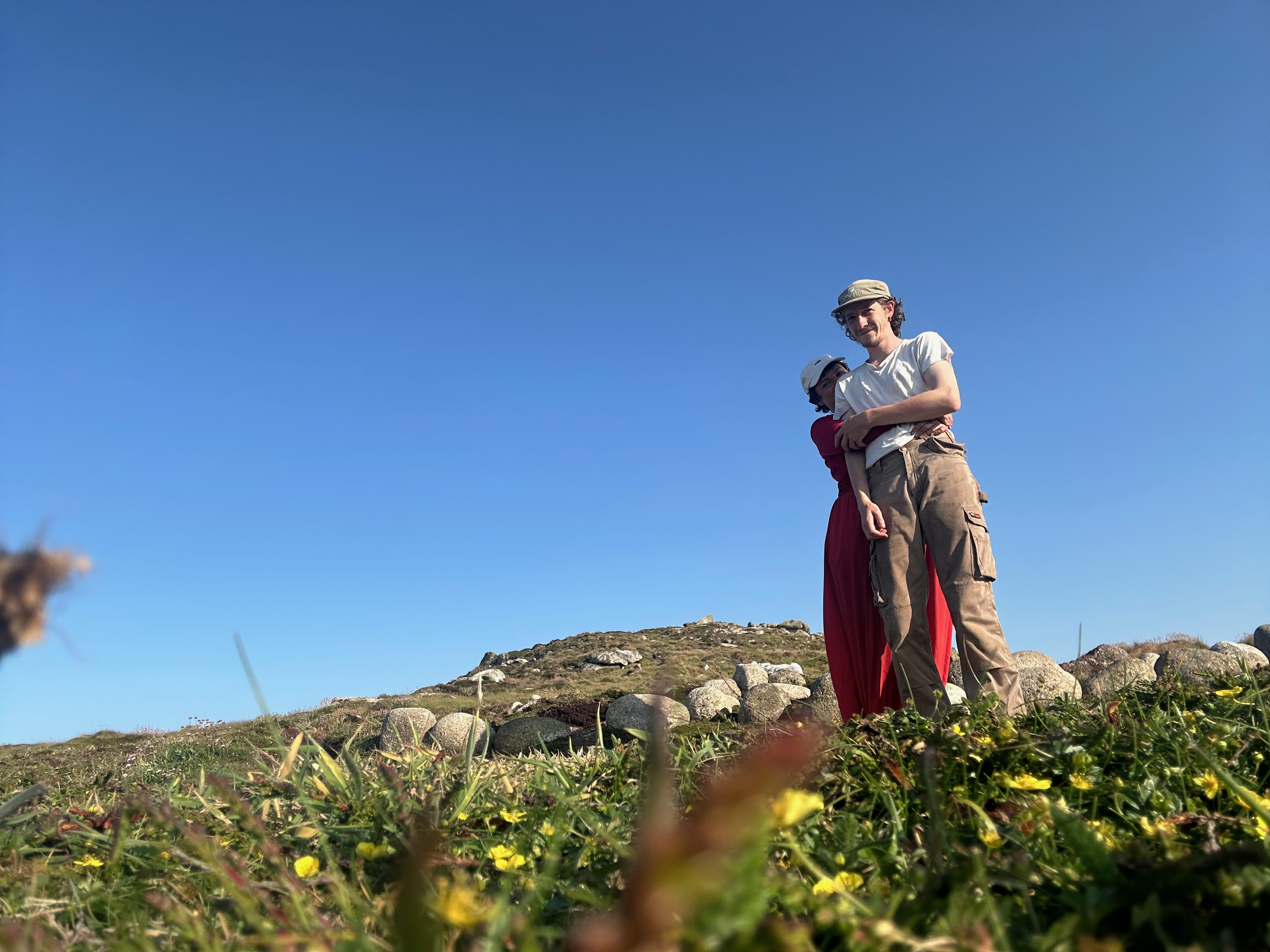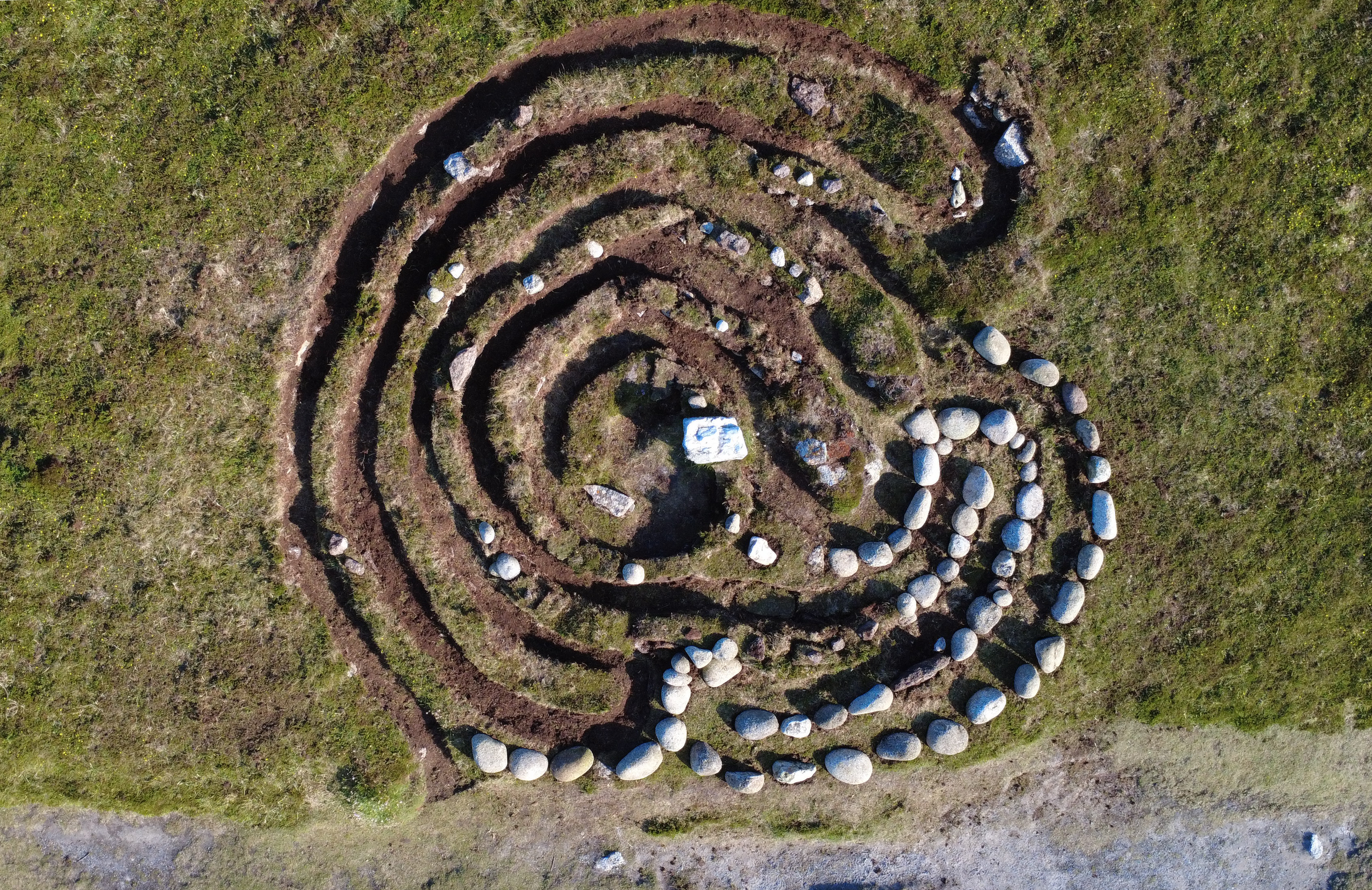Restoration of Giant’s Castle Maze
Over a week in mid June we successfully restored Giant’s Castle Maze! This has been a major aim of the project from the beginning and marks a key milestone for us as artists.
The restoration came after receiving expert archeological advice, an ecological survey from the Wildlife Trust, dowsing the site for energy lines, undertaking a table top survey of the site, commissioning 3D scans of the maze, plus seeking the advice of earth mysteries and ancient sites experts. We used all these findings to present islanders with different options of how the maze should be treated, and how the restoration - if any - should be approached.
The options for the restoration that we suggested (though there was also space for other suggestions) were:
Do nothing - allow the labyrinth to naturally fade into the surrounding landscape
Minimal maintenance - clear some vegetation to allow the stones that are still in situ to be more visible
More maintenance - clear some vegetation and built-up peat from some of the paths that are now hard to see, but don't add anything
Minimal restoration - build up some of the walls that are obviously eroded but keep the current layout as much as possible, and not altering the current position of the coast path
Restoration - re construct the labyrinth to a usable maze layout, interpreting scans, surveys, and historical documents to plan this, including the part now overlaid by the coastpath.
The below pie chart shows that overwhelmingly the people surveyed opted for a restoration, with 35.7% suggesting minimal restoartion and 64.3% suggesting full restoration.
Based on these findings, and on other comments we had received elsewhere, like “I think it would be good to have it restored” (a comment we received from a local man on Facebook) we opted for a full restoration, but one that was as low-impact as possible and kept as much of the existing shape as we could.
From our test excavation of the maze, we knew that the banks no longer necessarily corresponded with lines of stone underneath, and that the passage of people’s feet over the peat had created new banks and paths - which was something we wanted to preserve as much as possible. This meant that taking off all the turf to return to the stone pattern underneath (an earlier restoration idea) was ruled out. We adapted our plan for a “restoration” into more of a “continuation” asking:
“How can the banks and paths shaped by the passage of decades of feet be continued so that their shape becomes a usable labyrinth once more?”
The below images show the process of working out the best form for the restored/continued labyrinth to take. We opted to turn the maze (with dead ends and choices) back into a unicursal (single path) labyrinth for two reasons. Firstly, from a diagram of the site by Jeff Saward from 1990 it looks as if the maze did originally have only one path, and secondly, because we figured that if all the paths were walked the same amount (as with a unicursal design) then they should all erode at the same rate, which ought to stop some from becoming overgrown and lost again, giving the restored maze additional longevity.
To create this new shape, we switched between drawing a new, unicursal pattern over one of our 3D scans, to laying rope into the paths at the site, to aerial photography, and back and forth again - until we were finally happy with a design, which:
kept as much of the preserved maze shape as possible;
had only one path;
was an interesting labyrinth to walk (not just a spiral to the middle);
kept as many of the key features (like switchbacks and bends) as possible;
made any major changes to path shape in areas showing greatest erosion, while maintaining the well-built features.
We also had another unexpected but very welcome opinion to consider when undertaking this work, that of the original maze makers David and Helen, who made this labyrinth originally in 1952 when they were aged eleven and thirteen. After much detective work we managed to track down David and Helen, who came to our online sharing event and afterwards offered their suggestions for how the maze should be restored:
“We feel that you need to take a more radical approach to the maze’s restoration - replacement! The original maze was a success at the start because with the stones lying on the surface it was obvious and welcoming. However the stones were rough and of all shapes and sizes . They could easily be kicked to one side and the main track hidden. We think that you need something more creative. This is a prime site for a maze and should easily become by far the most visited maze in Scilly. You could relocate the maze on level ground back from the path adjacent to the present maze. Most importantly you would need to bring in flat sea washed stones like those at Troy Town. These should stay in position, would be easily seen from the path and should not be covered with heather.”
While we admire their sentiments that we should be more radical and creative with the re-design, we knew it would not be possible to move the maze back any further from the path because the scheduled monument ancient site of Giant’s Castle Iron Age Cliff Castle is just beyond the current edge of the maze. Scheduled monuments cannot be altered without express permission fro Historic England, who, we were pretty sure, would not be up for us disturbing this Iron Age relic to preserve our 1952 labyrinth. We were able to take on board David and Helen’s suggestion to use sea washed stones though, bringing these up from over the cliff edge nearby in a wheelbarrow and bedding them into the places where we needed to build new banks.
The restoration began with me and my grandad’s wheelbarrow hurtling off to the site in the drizzle ahead of the big predicted rain storm that was due to come in later that day. We wanted to collect as many stones for the rebuilding as possible before we started work with our volunteers.
The trek with the lonely wheelbarrow.
Approaching Giant’s Castle headland.
Selecting stones for the restoration.
Together with a small but incredibly dedicated team of volunteers, we did the work or restoring the labyrinth over a period of three days. On the first day our team was joined by Katharine Sawyer, archaeological advisor to the Isles of Scilly Wildlife Trust, who oversaw the restoration and ensured that we were approaching it responsibly. Katharine had already approved the plan for our new layout, and we laid this out on the ground with ropes, so we could remember where the path should be.
Restoration Day One: volunteers working on Giant’s Castle Maze. Photography by Gareth Tibbs.
Restoration Day One: Volunteers Emmy & Marthe, with archaeologist Katharine and Layan. Photography by Gareth Tibbs.
Restoration Day One: volunteers working on Giant’s Castle Maze. Photography by Gareth Tibbs.
As we worked on the maze, cutting some paths deeper and wider while while building up the banks between, we discussed the placement of the central stone. We were unsure whether we should move this stone back into it’s original position, as per the old drawings and diagrams of the maze, or leave it in it’s current position where it has been since 2022.
The central stone - an object of much mystery and speculation - had been moved out of the labyrinth in 2022 and put back again by concerned locals, though in a slightly different position to its original setting. How it was moved has remained a mystery… Was it rolled out by vandals? Blown out by a particularly strong gust of wind? Did the fairies move it? Did it crawl out by itself? We shall never know.
In our new spirit of continuation (not restoration) for the maze redesign, we decided to leave it where it was. We wanted to honour the choices of the many people who have formed the maze over the years, not just the two original maze makers, and we felt like this should definitely include the choices made by those who generously returned the central stone to the maze when it had been moved.
The central stone moved out of position (by an unknown force) in 2022, via Facebook.
On the second day we continued our work, and as we cut turf and moved rocks, we talked and joked. We were conscious that we were doing something very strange and unusual, but also - we felt - very beautiful. To be the people who didn’t just walk past an overgrown labyrinth and think “someone should do something about that” but instead thought “…maybe we should do something about that” and then to do it, felt like a very good use of our time and energy as artists.
Restoration Day Two: Volunteer Kate working with Layan on Giant’s Castle Maze.
We laid the stones we liked the most in prominent places, choosing ones with quarts geodes and interesting colours to go front and centre in the new maze design. Where possible, we kept all the original stones too, so - if you visit the maze you will see a mixture of sea washed stones (new) and ground-roughened granite (original).
Restoration Day Two: Volunteers Michael, Layla and Kate working to clear paths at Giant’s Castle Maze.
We used a technique called “soft capping” which Will Coleman (creator or Kerdroya labyrinth in North Cornwall) told me about when we recently met to talk labyrinths. This is where a dry stone wall is “topped” with turf, to stabilise the structure. We laid some of our cut turf on top of the places where we had to add new stones. We’re not sure whether this will settle in well this year or not, because it’s been a very hot, dry summer and there is no fresh water source out on Salakee Down which we could use to water it in. But we were assured by the Wildlife Trust that if these plants don’t survive that others will come in and fill the gap, creating a welcome element of diversity in the landscape, and likely providing structural support for the maze in one way or another.
End of Day Two: the Maze is almost complete - and ready to remove the guide-ropes. Many thanks to the Wildlife Trust and Bob Dawson for lending us tools.
The third day was a Monday and extremely hot. Layan and I came to the site to finish off setting the last stones, which took us longer than expected because we needed to detour for ice-cold milkshakes to maintain morale.
Day Three at the Maze - Teän & Layan.
Day Three at the Maze - Teän & Layan.
Then - all of a sudden - we were done! The last stone was laid and the last turf was cut. We tidied our tools and walked the first walk to the centre of the newly completed labyrinth design, making a wish when we reached the central stone.
The completed (restored/continued) labyrinth design.
Layan and our trusty wheelbarrow (now with a flat tyre - woops!) heading home after finishing the maze.
The finished maze at Giant’s Castle. Do stop and walk the paths when you are next passing by.
David and Helen told us that they made the original maze in an afternoon when they were eleven and thirteen. Our restoration took far longer, but this only shows how the maze has grown and developed - taking on a life of it’s own during the intervening years of being walked and re-walked, contemplated and wished in. It has become much bigger, more complicated and much more important - both physically and in the eyes of the community - than those two children could have ever imagined when they made it. We hope it will go on to live seventy more years and least - and maybe even further.
Heartfelt thanks to everyone who has worked on this with us and made the restoration possible.

